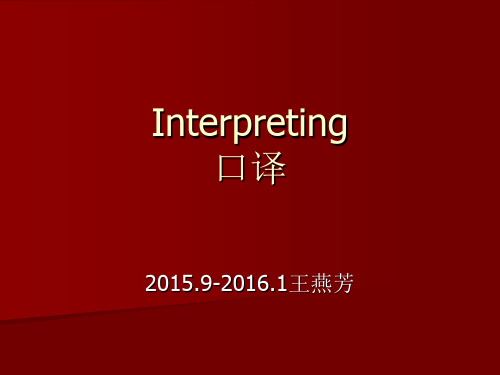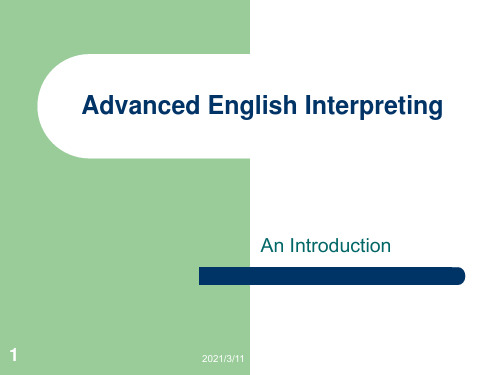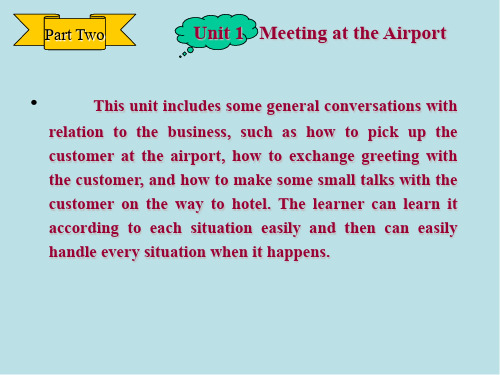口译基础unit1分析
合集下载
英语口译基础Unit One

Passage Interpreting 1
• East Asiatic公司, 在中国人们称之为宝隆洋行,简称宝隆。宝隆从1900年 起就在中国做生意,同中国贸易伙伴合作有90多年的历史了,我们对此感到 骄傲。// East Asiatic Company is better known in China as BaoLung YangHuang----BaoLung for short. BaoLung has been in China since 1900 and we are proud of our 90 years history of cooperation with China. 由于我们在中国的年头比较多,熟悉中国市场和我们的中国贸易伙伴的心理, 我们有一个能实现良好开端的基础。健康的贸易伙伴关系是建立成功的合资 企业的基础。我们十分重视与我们中国贸易伙伴不断发展良好的个人关系和 相互理解。我们要与我们的中国同行沟通思想,使他们了解我们是真诚认真 地想把合资企业搞成功的。// With our history in China as well as our knowledge of the market and the mentality of our Chinese business partners, we had the basis for a good start. We strongly believe that a sound business partnership is the foundation for a successful joint venture and we therefore attach great importance to the development of a good personal relationship and understanding with our Chinese partners. It is in this context that we communicate to our Chinese counterparts our sincerity and seriousness towards the success of our joint venture.
Unit 1 Interpreting 口译概况

心动不如行动!
口译的培训模式
同声传译模式: SI=L + M + P + C 同声传译(Simultaneous Interpreting)= 听力与分析(Listening and Analysis)+ 短期 记忆(Short-term memory effort) + 言语传 达(Speech Production)
Interpreting 口译
2015.9-2016.1王燕芳
Interpreting 口译
商务英语口译(黄敏) VOA慢速英语 VOA标准英语 CN理论、口译背景知识以及对学 生进行口译基本技巧的训练,使学生初步掌握口 译程序和基本技巧,初步学会口译记忆方法、口 译笔记、口头概述、公众演讲等基本技巧和口译 基本策略,培养学生关心时事的信息意识,积累 知识,掌握文献检索、资料查询的基本方法;培 养学生的话语分析能力,提高学生的逻辑思维能 力、语言组织能力和双语表达能力,提高学生跨 文化交际的能力和英、汉两种语言互译的能力。
难易程度 证书有效期
初级:三级 > 三级 > 中级 中级:二级 > 二级 > 高级 高级:一级 > 一级 > 无 每3年重新注册 登记一次,一次 注册有效期3年
暂无
暂无
口译的发展前景
在“非全日制就业人员工资指导价位”表 中列出的54种行业里,同声传译以每小时 2000元人民币的价格拔得头筹。 同声传译价目表中,英语类1天1.2万~2.1 万元人民币,非英语类是1.8万元人民币。 业内人士称,平均每星期做两次同声翻译, 一年平均50多万RMB。 交传一天的平均工资在3000-6000RMB.
口译与笔译的异同
英语口译基础教程-Unit-1-Introduction

KI=KL+EK+S (P+AP) 译员应该掌握的知识 =双语知识+百科知识 +技能(职业 口译技能 +艺术表达技能 )
– KI=Knowledge Required for an Interpreter – KL=Knowledge for language – EK=Encyclopedic Knowledge – S (P+AP)=Professional Interpreting Skills and
By ways: one-way interpreting 单向口译 two-way interpreting 双向口译
9
2021/3/11
Types of interpreting
By contents: guide interpreting 导游口译 ceremony interpreting 礼仪口译 information interpreting 宣传口译 conference interpreting 会议口译 negotiation interpreting 谈判口译
美 经 中美合企 2年 I 说 dif@bus. man. 中← →美// we 更 直 率 比 中←不同文传// I x 我 bus. ++ 毕 有 + & - @both // 近年 美企exe. 强: hu 中管//
13
2021/3/11
Example 2: How do you interpret?
今晚,我们很高兴在北京大学再次接待我们的老朋友格林博士和夫人。 /我代表学校的全体师生员工向格林博士和夫人及其他新西兰贵宾表示热 烈的欢迎。//
我相信格林博士这次对我校的访问,必将为进一步加强两校的友好合 作关系作出重要的贡献。//
大学核心商务英语口译教程unit (1)

• 第六段-3:The US is the second largest export market of China and its sixth largest source of import, while China is the third largest export destination and the biggest import source of the US, and has been the fastest growing major export market of the US for 7 years in a row.
• 第二段-1:As Vice Minister of Commerce in charge of high-tech trade and export control, I am deeply aware of the significance of this job. Mutual trust is the key to and communication the basis for expanding hightech trade between China and the US.
• 第六段-2:According to Chinese figures, bilateral trade in goods reached US$ 333.7 billion in 2008, quadrupling that of 2001 with an average annual growth rate of 19.5%. The US export to China stood at US$ 81.5 billion, trebling that of 2001 with an average annual growth rate of 15.2%. The two countries are each other’s second largest trading partner.
口译基本理i

• 14 Ici c’est l’accueil. Vous êtes Monsieur Fernandez ? Monsieur Wang, de la société d’Import-Export de Shanghai est arrivé. Il vous attend dans la salle 203. • 15 Mon séjour à Shanghai a été agréable et cette visite a été fructueuse pour nos relations commerciales. Je pense que nous aurons l’occasion de nous revoir bientôt à Paris.
• 12 C’est très gentil d’être venu m’attendre. C’est la première fois que je viens en Chine et tout est nouveau pour moi. • 13 Monsieur Fourré m’a chargé de vous transmettre ses salutations et ses hommages à Madame Li, il n’a jamais oublié sa visite à Canton il y a deux ans parmi vous.
• 3 Je voudrais vous inviter à prendre des plats régionaux au restaurent ce soir, êtes-vous libre ? • 4 Je propose de porter un toast à la santé de nos amis français. • 5 Je vous invite à lever votre s distingués !
商务英语口译Unit 1 Meeting at the airport

of the scenery along the way, or changes in the city. In this way, silence can/should be avoided. And it also can help the guests learn the city which they are visiting. Anyway, it is the basic courtesy of hospitality.
Part Two
Unit 1 Meeting at the Airport
• W: Yes, I’ve been there once last year. • L: Do you like China? • W: Yes, it’s a nice place. • L: Do you smoke? • W: No, thanks. I just quit smoking. • L: Really? Oh, it’s not easy. I tried many times, but always
Part Two
Unit 1 Meeting at the Airport
• Dialogue Two On the Way to Hotel (1) • (It is on the way to the hotel, and Li Hua is talking with Mr.
Wilson and Mr. Parker' about their trips in Guangzhou.)
• L: Excuse me; are you Mr. Wilson from the International Trading Corporation?
大学核心商务英语口译教程unit (1)

• 第六段-2:According to Chinese figures, bilateral trade in goods reached US$ 333.7 billion in 2008, quadrupling that of 2001 with an average annual growth rate of 19.5%. The US export to China stood at US$ 81.5 billion, trebling that of 2001 with an average annual growth rate of 15.2%. The two countries are each other’s second largest trading partner.
• 第六段-1:China-US economic and trade ties are an important foundation and component of the relationship. Since the two countries established diplomatic relationship 30 years ago, bilateral economic and trade relations have developed steadily and soundly thanks to the joint efforts of the two governments and business communities.
• 第二段-2:With government officials and business representatives from both sides sitting down together, this meeting will play an important role in boosting mutual understanding and mutual trust between the Chinese and US governments and industries, ensuring the sound development of Sino-US high-tech trade, and benefiting the two peoples.
口译教程第一课

Ⅳ. Homework
Listening for logic
Theme: Logical analysis Procedures: Ⅰ. Theory and skills (40 min)
1. Vertical analysis of logic 2. Horizontal analysis of logic
相同点:都需要将一种语言经过理解和重组用另一种语言表达出来;
翻译者都必须精通两种语言、文化和转换技巧。
4. Characteristics of Interpreting (口译的特点)
二、口译练习 1.质量要求 2.译前准备
2.1课前检索与阅读 2.2课前检查 3.对话口译 从事旅游业 4.篇章口译 4.1 an introduction to an industrial village 4.2 being a traveler,not a tourist 4.3长城景区导游词 4.4旅游论坛致辞 三、日积月累 四、译员须知 礼仪常识
3分钟以上即可称为长交传
交替传译常用于新闻发布会、外事会见、商务谈判、户外活动等
3.Types of interpreting(口译分类)
1)根据时间工作模式,可分为交替传译和同声传译
同声传译:simultaneous interpreting 简称 SI
又称同步口译、即时传译(港台用语)
简称“同传”
使用法语和英语两种语言,有了交传译员。 1926年:IBM发明了同传设备,被认为是口译史上最重要
的发明。 1945年:纽伦堡军事法庭审判,使用了英法德俄四种语言,
会上大规模使用同声传译。 1947年:联合国采纳同传。 1971年:中国重返联合国,中国的口译活动增加。 改革开放之后:口译活动得到快速发展,多以交传为主。 20世纪90年代后期开始:中国的大型国际会议增多,同传
Listening for logic
Theme: Logical analysis Procedures: Ⅰ. Theory and skills (40 min)
1. Vertical analysis of logic 2. Horizontal analysis of logic
相同点:都需要将一种语言经过理解和重组用另一种语言表达出来;
翻译者都必须精通两种语言、文化和转换技巧。
4. Characteristics of Interpreting (口译的特点)
二、口译练习 1.质量要求 2.译前准备
2.1课前检索与阅读 2.2课前检查 3.对话口译 从事旅游业 4.篇章口译 4.1 an introduction to an industrial village 4.2 being a traveler,not a tourist 4.3长城景区导游词 4.4旅游论坛致辞 三、日积月累 四、译员须知 礼仪常识
3分钟以上即可称为长交传
交替传译常用于新闻发布会、外事会见、商务谈判、户外活动等
3.Types of interpreting(口译分类)
1)根据时间工作模式,可分为交替传译和同声传译
同声传译:simultaneous interpreting 简称 SI
又称同步口译、即时传译(港台用语)
简称“同传”
使用法语和英语两种语言,有了交传译员。 1926年:IBM发明了同传设备,被认为是口译史上最重要
的发明。 1945年:纽伦堡军事法庭审判,使用了英法德俄四种语言,
会上大规模使用同声传译。 1947年:联合国采纳同传。 1971年:中国重返联合国,中国的口译活动增加。 改革开放之后:口译活动得到快速发展,多以交传为主。 20世纪90年代后期开始:中国的大型国际会议增多,同传
- 1、下载文档前请自行甄别文档内容的完整性,平台不提供额外的编辑、内容补充、找答案等附加服务。
- 2、"仅部分预览"的文档,不可在线预览部分如存在完整性等问题,可反馈申请退款(可完整预览的文档不适用该条件!)。
- 3、如文档侵犯您的权益,请联系客服反馈,我们会尽快为您处理(人工客服工作时间:9:00-18:30)。
词汇量、语法知识、阅读理解能力
汉语:词汇量、措辞能力、组句能力、修辞能力、 文学修养、古汉语知识
b 宽广的知识面:要了解百科基本知识,具备社会科学 人文科学和自然科学领域内的一般知识;关注国内外的 时政新闻和热点话题:科技进步、种族冲突、经济全球 化等。Know everything of something, and something of everything
IBM first patented SI as a technique in 1926.
In 1947, SI for English, French, Russian and German used full scale at the Nuremberg trial. SI has been with UN since 1947.
c 跨文化意识:口译是跨语言、跨文化的交际活动,其 最终目的是要让听众和讲话人达到思想文化的交流。
B 非智力因素
心理素质 身体素质 态度 责任心
IV. Brief History of Conference Interpreting
During the 1919 Paris Peace Conference, CI debuted officially.
Lecture 1 course description
Course objectives:
To familiarize you with the basic requirement of being an interpreter
To offer you basic training in the interpreting skills.
各章节教学内容纲要 口译职业技能介绍
听辨
口译记忆
公众演讲 数字口译技巧
口译笔记
综合练习 复习考试
教学形式
知识介绍
课堂讲解,技能 训练
课堂讲解,技能 训练
课堂讲解,专题 训练
课堂讲解,专题 训练
课堂讲解,技能 训练
技能训练
面试
时间安排 1周 2-5周
6-7周
8-9周 10-11周
12-13周
14-17周 18周
In Chinese history, interpreters used to be called Tongues Man(舌人
V. 口译的主要形式
根据信息的传递形式,可分为 交替传译(连续传译)consecutive interpreting 同声传译 simultaneous interpreting
Textbooks for reference:
《口译基础》,苏伟,邓轶主编,上海外语教育出版社 《英语口译基础教程》,仲伟合主编,高等教Skill-based, topic-oriented
Theory explanation Skill-training Practice
Interpreting as a profession: the foundation of International Association of Conference Interpreters (AIIC) in 1953.
Chinese was accepted as a working language in late 1970s.
Course requirements:
Attendance (punctuality) Class participation In-time handling of assignment
Evaluation:
Attendance Assignment In-class performance Final exam (in oral form)
工作方法不同
口译员通常独自工作,口译时一般无法求助于他人,也 没时间查阅词典或其他材料。而笔译员则可以随时查阅 各种参考书,反复斟酌,也可请教相关领域的专家。
反馈形式不同
口译是现场的翻译活动。译员面对讲话人和听众,可以 随时从他们的面部表情、情绪、手势和其他身势语中接 收到反馈信息,译员可根据现场的情况和听众的反馈及 时调整自己的音量、语速、用词等。而笔译员在翻译过 程中一般没有机会与作者和读者面对面进行交流,也无 法根据他们的反馈进行调整和修改。
• 第一周: • 教学目的:使学生了解口译基本知识 • 教学内容:
I. 口译与笔译的不同:
工作环境不同:
口译具有很强的现场性和时限性。口译员必须面对公众 现场翻译,而笔译的工作环境则无限制。口译一般有很 强的时限性,口译员一般不能对已经翻译过的内容进行 大量的更正和补充,除非发现重大错漏。而在笔译中, 译者大多有充足的时间反复阅读原文,翻译完初稿后, 还可以反复修改润色直到译者满意为止。
II. Why to Be a Professional Interpreter?
4 Goods: Good places to visit Good food to eat Good money to make Good people to meet
III. 口译能力的构成:
A 智力因素
a 双语支柱 外语:听力是基础 1200个tape hours
To introduce to you the most frequently touched topics in real interpreting work and familiarize you with the basic vocabulary in those areas.
To practise in and out of class.
根据口译的场合和内容,可分口译为 会议口译 conference interpreting 商务口译 business interpreting 法庭口译 court interpreting 媒体口译 media interpreting 社区口译 community interpreting 电话口译 telephone interpreting
质量标准不尽相同
笔译讲究“信、达、雅”,口译则强调“准、顺、快”。“ 即准确,指准确理解原语信息并即时将其译成目的语。 “顺”即通顺,指译员在用目的语表达原语信息时要通顺 流畅,符合语言表达规范。“快”即译员反应要快,讲话 者的话音刚落,译员就要开始翻译。另外,口译质量的 判定还取决于参与交际的各方(如讲者、听者和雇主) 从各个角度所认定的交际效果。
汉语:词汇量、措辞能力、组句能力、修辞能力、 文学修养、古汉语知识
b 宽广的知识面:要了解百科基本知识,具备社会科学 人文科学和自然科学领域内的一般知识;关注国内外的 时政新闻和热点话题:科技进步、种族冲突、经济全球 化等。Know everything of something, and something of everything
IBM first patented SI as a technique in 1926.
In 1947, SI for English, French, Russian and German used full scale at the Nuremberg trial. SI has been with UN since 1947.
c 跨文化意识:口译是跨语言、跨文化的交际活动,其 最终目的是要让听众和讲话人达到思想文化的交流。
B 非智力因素
心理素质 身体素质 态度 责任心
IV. Brief History of Conference Interpreting
During the 1919 Paris Peace Conference, CI debuted officially.
Lecture 1 course description
Course objectives:
To familiarize you with the basic requirement of being an interpreter
To offer you basic training in the interpreting skills.
各章节教学内容纲要 口译职业技能介绍
听辨
口译记忆
公众演讲 数字口译技巧
口译笔记
综合练习 复习考试
教学形式
知识介绍
课堂讲解,技能 训练
课堂讲解,技能 训练
课堂讲解,专题 训练
课堂讲解,专题 训练
课堂讲解,技能 训练
技能训练
面试
时间安排 1周 2-5周
6-7周
8-9周 10-11周
12-13周
14-17周 18周
In Chinese history, interpreters used to be called Tongues Man(舌人
V. 口译的主要形式
根据信息的传递形式,可分为 交替传译(连续传译)consecutive interpreting 同声传译 simultaneous interpreting
Textbooks for reference:
《口译基础》,苏伟,邓轶主编,上海外语教育出版社 《英语口译基础教程》,仲伟合主编,高等教Skill-based, topic-oriented
Theory explanation Skill-training Practice
Interpreting as a profession: the foundation of International Association of Conference Interpreters (AIIC) in 1953.
Chinese was accepted as a working language in late 1970s.
Course requirements:
Attendance (punctuality) Class participation In-time handling of assignment
Evaluation:
Attendance Assignment In-class performance Final exam (in oral form)
工作方法不同
口译员通常独自工作,口译时一般无法求助于他人,也 没时间查阅词典或其他材料。而笔译员则可以随时查阅 各种参考书,反复斟酌,也可请教相关领域的专家。
反馈形式不同
口译是现场的翻译活动。译员面对讲话人和听众,可以 随时从他们的面部表情、情绪、手势和其他身势语中接 收到反馈信息,译员可根据现场的情况和听众的反馈及 时调整自己的音量、语速、用词等。而笔译员在翻译过 程中一般没有机会与作者和读者面对面进行交流,也无 法根据他们的反馈进行调整和修改。
• 第一周: • 教学目的:使学生了解口译基本知识 • 教学内容:
I. 口译与笔译的不同:
工作环境不同:
口译具有很强的现场性和时限性。口译员必须面对公众 现场翻译,而笔译的工作环境则无限制。口译一般有很 强的时限性,口译员一般不能对已经翻译过的内容进行 大量的更正和补充,除非发现重大错漏。而在笔译中, 译者大多有充足的时间反复阅读原文,翻译完初稿后, 还可以反复修改润色直到译者满意为止。
II. Why to Be a Professional Interpreter?
4 Goods: Good places to visit Good food to eat Good money to make Good people to meet
III. 口译能力的构成:
A 智力因素
a 双语支柱 外语:听力是基础 1200个tape hours
To introduce to you the most frequently touched topics in real interpreting work and familiarize you with the basic vocabulary in those areas.
To practise in and out of class.
根据口译的场合和内容,可分口译为 会议口译 conference interpreting 商务口译 business interpreting 法庭口译 court interpreting 媒体口译 media interpreting 社区口译 community interpreting 电话口译 telephone interpreting
质量标准不尽相同
笔译讲究“信、达、雅”,口译则强调“准、顺、快”。“ 即准确,指准确理解原语信息并即时将其译成目的语。 “顺”即通顺,指译员在用目的语表达原语信息时要通顺 流畅,符合语言表达规范。“快”即译员反应要快,讲话 者的话音刚落,译员就要开始翻译。另外,口译质量的 判定还取决于参与交际的各方(如讲者、听者和雇主) 从各个角度所认定的交际效果。
